科技英语课本学习知识句子翻译Unit10
- 格式:doc
- 大小:77.32 KB
- 文档页数:10
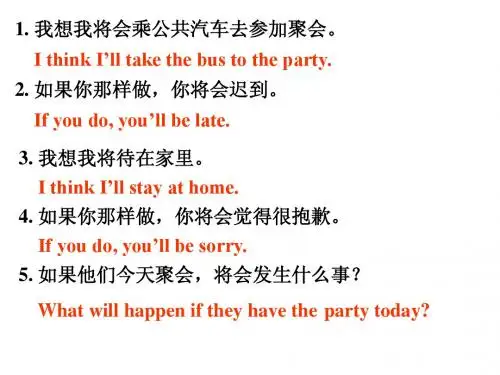
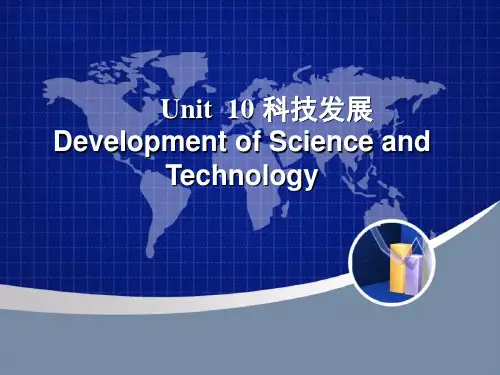
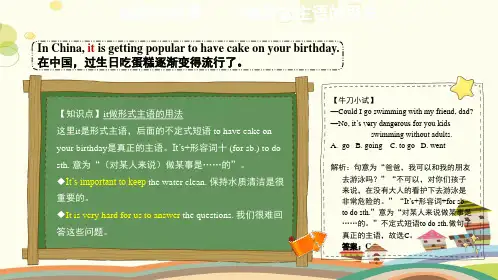
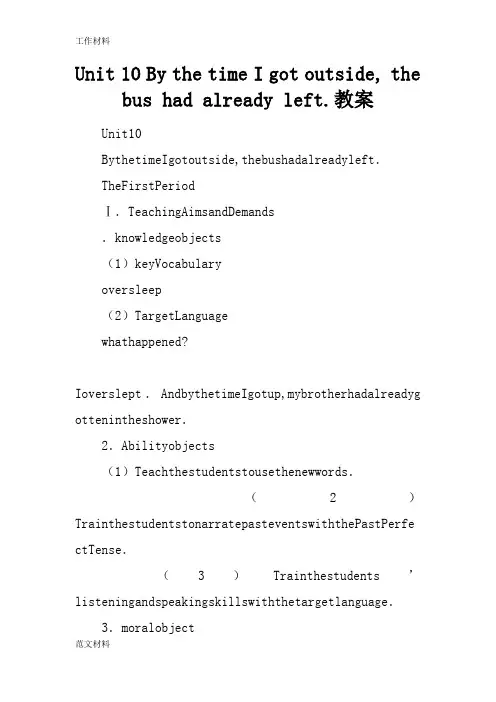
Unit 10 By the time I got outside, the bus had already left.教案Unit10BythetimeIgotoutside,thebushadalreadyleft.TheFirstPeriodⅠ.TeachingAimsandDemands.knowledgeobjects(1)keyVocabularyoversleep(2)TargetLanguagewhathappened?Ioverslept.AndbythetimeIgotup,mybrotherhadalreadyg ottenintheshower.2.Abilityobjects(1)Teachthestudentstousethenewwords.(2)TrainthestudentstonarratepasteventswiththePastPerfe ctTense.(3)Trainthestudents’listeningandspeakingskillswiththetargetlanguage.3.moralobjectIt’sagoodhabittogotobedearlyintheeveningandgetupearlyi nthemorning.Soyou’llneverbeinahurryinthemorning.Ⅱ.TeachingkeyPoints.keyVocabularyoversleep2.TargetLanguageNarratepasteventswiththePastPerfectTenseⅢ.TeachingDifficultPoints.TrainthestudentstonarratepasteventswiththePas tPerfectTense.2.Trainthestudentstounderstandthetargetlanguageins pokenconversation.Ⅳ.Teachingmethods.Thinkingofexamplesfromthestudents’reallives.2.makingsentencesbylookingatthepictures.Ⅴ.TeachingAidAtaperecorderⅥ.TeachingProceduresStepIRevision.RevisethelanguagepointsinUnit8.Asksomequestionslikethis:whatvolunteerworkwouldyoul iketodo?Helpthestudentstoanswer,I’dliketo…/Iloveto…/Ihopeto…2.PracticethedialogueinActivity3conpage62again.Ge tstudentstoroleplaythesimilardialogueswiththefollow ing.SA:I’dliketojointheschoolvolunteerproject,butI’mnotsurewhatIshoulddo.SB:whatdoyoulikedoing?SA:Iloveplayingfootball.SB:well,youcouldhelpcoachafootballteamforlittlekids .Letthechildrenpracticeinpairs.3.checkthestudents’homeworkbyaskingsomestudentstoreadtheirsentenceswit hthephrasalverbs.Thenaskthestudentstohandintheirho mework.4.Dictatethefollowingwords:cleanup,cheerup,giveout,putoff,setup,runoutof,takea fter,fixup,giveaway,callup,handout,workout,hunger,establish,commit ment,veterinarian,strategyStepⅡ1aThisactivityintroducesnewvocabularywhichcanbeusedto narratepastevents.Firstwritebythetimeontheblackboard.andtelltheclass themeaningofit."bythetime"meansnotlaterthan,before,assoonas,orwhen theindicatedcomes.whenweusethewords."Bythetime…, "wearetalkingabouttwodifferentthingsthathappenedint hepast.Saythissentencetotheclass:Bythetimetheteach ercamein,thestudentshadbegunreadingEnglish.Tellthemtonotethestruture"hadbegun"inthissentence.Begunisthepastparticipleofbegin.whenwetalkabouttwo eventsbothhappenedinthepast,theonewhichhappenedearliershoulduseandplusapastparticiple.Thewordsfollowi ngBythetime…,talkaboutthethingthathappenedlater.A ndtellthestudentswhentheyusehadplusapastparticiple, theyareusingthePastPerfectTense.Alsoexplainwhatist hepastparticipleformofaverbforthestudents.Tellthem itisasthesameasthepastformforaregularverb.Andtheyh avetoremembertheirregularverbs’participlesonebyone.Playagametohelpthestudentsunderstandthesentenceswit hthewordsBythetime…Doitlikethis:Pretendthattheteacherwillleavetheclassroomandthestu dentswilldosomethings.whentheteacherreturns.thecl asswillmakestatementsstartingwithBythetime…writeBythetimeIcameback…ontheblackboard.Saytotheclass,BythetimeIcamein.whathadhappened?Helponestudenttoanswerlikethis,Bythetimetheteacherc amein,Donhadwrittenhisnameontheblackboard.Thengetmorestudentstoanswerdifferently,suchas,Bythelimetheteachercamein,wehaddiscussedanEnglishproblem.Bythetimetheteachercamein,Ihaddrawnapicture.writethesesentencesontheblackboard,andteachthestude ntstoreadseveraltimes.Readtheinstructionstothestudentsandreadthesequestio nstotheclassaswell.whatdoyouusuallydoin,themorningbeforeschool?Doyouli kemorning?whyorwhynot?chooseonegoodstudenttoanswerthembysayingsomethinghe orsheusuallydoesinthemorning.Heorshemayanswerlikethis,Iusuallygetupearly,washmyfaceandhavebreakfast.Ilik emorningsbecausetheairisfresh,orIusuallygetupaslate aspossible.ThenIhavetowashmyfaceandhavebreakfastin ahurry.Ioftenrushtoschoolwithoutbreakfast.Sometim esIforgetsomethingathome.Idon’tlikemorningsbecauseIamalwaystoobusy.Thenhavethewholeclasspracticeinpairs.Askeachothert hequestions.Aftertheyfinishtalking,askoneortwopairstosaytheirco nversationstotheclass.correctthemistakestheymaymak ewiththeotherstudents.callthestudents’attentiontothepicturesinActivityla.Askstudentstote llwhattheysee.Say,Anysentenceswhichmakesenseareacceptedtodescribe thepictures.ThegirlinthepicturesisTina.Presentthenewwordsbypro vidingsentencesshowingthemeaningsofthemlikethis: T:whatcanyouseeinPicture1?S1:Shesleptalongtime.T:That’scorrect.Sheslepttoolate.Sheoverslept.classrepea t.Sheoverslept.Ss:Sheoverslept.T:whatdoyouseeinPicture2?S2:Herbrotherorsisterisinthebathroom.T:That’scorrect.Shewantstogointothebathroom.Shecan’tbecausesomeoneistakingashower.classrepeat.Someon eistakingashower.Ss:Someoneistakingashower.writethesewordsontheblackboard:overslept,takingashower,hadleft,leftherbackpackatho me.Thentellstudentstotalkaboutthepicturesingroupsoffou r.movearoundtheclassroom,listeningtostudentsandoff eringhelp.makesurethattheytalkinEnglish.Aftertheyallfinishtalking,askdifferentgroupstotellt heclassaboutthepictures.Theymaysaylikethis:Tinaoversleptinthemorning.Shewantedtogotothebathro om,butherbrotherhadalreadygottenintheshower.whenshegottothebusstop,thebushadalreadyleft.Shehadtoruntoschool.Aftershegottoschool,sherealize dshehadleftherbackpackathome.Thesentencescanvary,b utshouldbecorrect.StepⅢ1bThisactivitygivesstudentspracticeinunderstandingthe targetlanguageinspokenconversation.Askthestudentstoreadtheinstructionstogether.Haveth emlookatthetwocolumns,AandB,inthechart.Pointoutthe sampleanswer.Readthetwopartsofthesentence.Thengoovertheotherunconnectedpartsofsentences,too.youwillconnectthetwopartsofthesentences,connectasen tencebeginninginthefirstcolumnwiththeendofthatsente nceinthesecondcolumn.Pleaseguesstheothertwosentenc esbeforeIplaythetape.Iguessmostofthechildrencangetthecorrectsentencesbyguessing.Sojustletthemguess.Don’ttellthemwhethertheiranswersarerightorwrong.ok,justkeepyouranswersbyguessing.Let’sdecideiftheyarerightbylisteningtothetapenow.Playtherecordingforthefirsttime.Studentsonlylisten.Thenplayitasecondtime.Letstude ntsmatchtwopartsofeachsentence.checktheanswersbyas kingsomestudentstotelltheiranswers.makesurethatallofthemhavegotthecorrectanswersbylist ening.Saycongratulationstothestudentswhogettheansw erscorrectlybyguessing.Answers.b2.a3.cTapescriptBoy:Hi,Tina.youlookstressedout.Girl:Iam.Ihadabadmorning.Boy:Really?whathappened?Girl:well,firstofallIoverslept.BythetimeIgotup,mybrotherhadalreadygottenintheshower.Boy:oh,whatapain!Girl:So,afterhegotoutofshower,Itookaquickshowerandg otdressed.ButbythetimeIwentoutside,thebushadalread yleft.Boy:oh,no!Girl:oh,yes!SoIranallthewaytoschool.ButwhenIgottos chool,IrealizedIhadleftmybackpackathome.Boy:Nowonderyoulookstressedout.StepⅣ1cThispracticeprovidesguidedoralpracticeusingthetarge tlanguage.FirstplaytherecordinginActivity1b againandletthestudentsreadafterit.Doitatleasttwice.Thenreadtheinstructionstogetherwiththewholeclass.youwillmakeconversationsinpairs.EachofyouwillhavetotaketurnsbeingTina.LookatthepicturesinActivitylat ohelpyou.Tellyourpartnerwhathappenedtoyouthismorni ng.Askapairtoreadtheexampletotheclassbeforetheybeg irtSA:whathappened?SB:Ioverslept.AndbythetimeIgotup,mybrotherhadalrea dygottenintheshower.writetheconversationontheblackboard.Havethestudentsworkinpairs.movearoundtheroomofferi nglanguagesupportasneeded.Aftertheyallfinishtalking,asksomepairstosaytheircon versationstotheclass.StepⅤSummarySay,Inthisclass,we’velearnedhowtonarratepastevents,usingthePastPerfectTense.we’vealsodonesomelisteningpracticeinunderstandingtheta rgetlanguageinspokenconversation.Also,we’vedonemuchoralpracticeusingthetargetlanguage.StepⅥHomework.writeoutthestoryofTina,Notetousethetargetlang uage.2.RevisewhentousethePastPerfectTenseandtheverbstru ctureofit.StepⅦBlackboardDesignUnit9BythetimeIgotoutside,thebushadalreadyleft.SectionATheFirstPeriod.Bythetime…Bythetimetheteachercamein,thestudentshadbegunreadin g.Bythetimetheteachercamein,Donhadwrittenhisnameonthe blackboard.Bythetimetheteachercamem,wehaddiscussedanEnglishpro blem.2.Somewordstodescribethepicturesoverslept,takingas hower,hadleft,leftherbackpackathome.3.TargetLanguage:A:whathappened?B:Ioverslept.AndbythetimeIgotup,mybrotherhadalread ygottenintheshower.Unit9BythetimeIgotoutside,thebushadalreadyleft.TheSecondPeriodⅠ.TeachingAimsandDemands.knowledgeobjects(1)TargetLanguageBythetimeshegottoclass,theteacherhadalreadystartedt eaching.whenshegottoschool,sherealizedshehadleftherbackpack athome.whenIgothome,IrealizedIhadleftmykeysinthebackpack.(2)TheThreeFormsoftheverbs.2.Abilityobjects(1)Trainthestudents’listeningskill.(2)Trainthestudents’writingskillwiththetargetlanguage.(3)Trainthestudents’speakingskill.(4)Trainthestudentstousethethreeformsoftheverbs.3.moralobjectTrytobeacarefulpersonanddoeverythingcarefully.Reme mbernottobeascarelessasTina.Ⅱ.TeachingkeyPoints.Listeningpracticewiththetargetlanguage.2.Usethecorrectverbformstofillintheblanksbylisteni ng.3.makesentencesusingthePastPerfectTense.4.Thethreeformsoftheverbs.Ⅲ.TeachingDifficultPoints.writeanendingforthestoryinActivity2c.2.ThethreeverbformsinGrammarFocus.Ⅳ.Teachingmethods.Listening2.PairworkⅤ.TeachingAidsAtaperecorderⅥ.TeachingProceduresStepIRevision.RevisewhathappenedtoTinainthemorningbyaskingo neortwostudentstotellthestroyonpage68.Theymaysaylikethis:Tinahadabadmorning.Firstofallsheoverslept.Bytheti meshegotup,herbrotherhadalreadygottenintheshower.Andbythetimeshewentoutside,thebushadalreadyleft.Sh ehadtorunallthewaytoschool.whenshegottoschool,sher ealizedshehadleftherbackpackathome.Allthesemadeher lookstressedout.Afterthat,askthewholeclasstoworkin pairs,tellingthestroyandhelpingeachotherinturns.Re mindthemtousethecorrectverbforms.2.Askstudentstocheckeachother’shomeworkinpairs,pointingoutallthemistakestheymighthavemade.3.RevisethePastPerfectTensebyaskingthechildrenwhen touseitandwhatitsverbstructureis.StepⅡ2aThisactivityprovidesguidedlisteningpracticeusingthe targetlanguage.wehaveknownTinahadabadmorning.ButsomethingworsehappenedtoTinalater.Let’sgotoActivity2aonpage69andseewhathappenedtoTinalate rinthemorning.Readtheinstructionstotheclass.Besurethatallofthemk nowwhattodo.callthestudents’attentiontothefourpictures.Getthemtoguessthecorrec torderofthepicturesfirst.Thefirstoneisgivenasasamp le.Askoneortwochildrentotelltheirstoriesbydescribi ngthepicturesaccordingtotheirownorder.Then,wewillhearTinatalkingaboutwhathappenedtoheraftershegottoschool.wecanseethereisasmallboxineachpic ture.Pleasewriteanumberfrom1to4ineachboxtoshoweachpictur e’scorrectorder.Thefirstonehasbeengivenasasample.GetthechildrentogetreadytolistentoTinacontinueherst ory.Playtherecordingthefirsttime,studentsonlylisten.Pl aytherecordingagainandaskthechildrentonumbereachpic ture.checktheanswerswiththeclassandseewhohaveevergotthec orrectanswerswithoutlistening.AnswersThepicturesshouldbenumberedinthisorder:3124TapescriptBoy:Sothenwhatdidyoudo,Tina?Girl:well,Iranhometogetmybackpack.ButwhenIgothome,IrealizedIhadleftmykeysinthebackpac k.Boy:you’rekidding!Girl:SoIranbacktoschoolwithoutmykeysormybackpack.A ndbythetimeIgotbacktoschool,thebellhadrung.Boy:oh,no!Girl:AndbythetimeIwalkedintoclass,theteacherhadstar tedteachingalready.Sheaskedforourhomework,butofcou rseIdidn’thaveit.StepⅢ2bThisactivitygivesstudentspracticeinunderstandingand writingthetargetlanguage.Askthestudentstoreadtheinstructionstogether.Pointo uttheblanksinthesentencesandtheverbsinthebrackets.Thisactivityhastwoparts.Firstlet’sfillintheblankswiththecorrectverbforms.wecanseeso meverbsinthebrackets.Theyarethebaseformsofthegivenverbs.Forexample,getandgot,Getisthebaseformoftheve rb.yourjobistowritethecorrectformsoftheseverbsinth eblanks.Lookatnumberone.Asampleanswerisgiven.Letthestudentsfillintheblankswiththecorrectformsind ividually.movearoundtheclassroomcollectingthecommonmistakesth eymaymake.Aftertheyallfinishwriting,tellthemtogetreadytoliste ntotheconversationandchecktheiranswers.Iwillplaytherecordingagain.Pleasecheckyouranswersa ndcorrectanymistakesyoumighthavemadewhilelistening .Playtherecording.Studentslistenandchecktheiransw ers.correcttheanswersbyaskingsevendifferentstudent stosaytheirstotheclass.Answers.gothome2.realized3.hadleft4.got5.hadrung6.walked7.hadstartedStepⅣ2cThisactivitygivesstudentsoralpracticewiththetargetl anguage.Askthewholeclasstoreadtheinstructionstogether.wehaveanewtasknow.weknowTinawaslateforclass.whatd oyouthinkhappenedafterTinawaslateforclass?workwithapartner.makeupanendingforthestorybycontin uingit.Thebeginninghasbeengiven.Getstudentstodiscussinpairs.completetheending.mak esuretheyaretalkinginEnglish.movearoundtheclassroo m,offeringlanguagesupportifneeded.Aftertenminutes, askstudentstostopdiscussing.Getsomepairsofstudents totelltheclasshowtheythinkthestoryendedAndletthewho leclassdecidewhoseendingisthebest.Telleachpairtowr itedowntheirending,ordoitafterclassiftimeisnotenoug h.SampleendingofthestoryTheteacherlookedatTinaandsaid,"whyareyoulateandwher eisyourhomework,Tina?""Ihadabadmorningtoday."Tinas aidsadly."I’msorrytohearthat,butmayIknowwhathappened?saidthetea cher.ThenTinatoldtheteacherandthewholeclassherstory.All herclassmateslaughedloudlyafterit.Someofthemsaid," PoorTina!"Bob,oneofTina’sclassmates,stoodupandsaid,"well,Tina,I’dlovetohelpyou.whynotletmekeepthekeysforyou?Iwould putyourkeysinmybackpack."StepⅤGrammarFocusThisactivityintroducesthetargetlanguageofthisunit.callstudents’attentiontothesentencesontheleft.Askfourdifferents tudentstoreadthefoursentencesandpointoutwherehadplu sapastparticipleisused.writethesentencesontheblack board.Drawasimpletimelineforeachsentencetohelpstudentstou nderstandthegrammarfocus.Forexample:Thengetthestudentstolookatthebox.Teachstudentstoreadthethreeformsofeachverbsfirst.T henaskseveralstudentstoreadtheverbstotheclasstoseei ftheycanread.writetheverbsontheblackboard.Askthestudentstomakesentencescorrectlyusingeachform oftheverbsinthebox.Forexample:Iusuallygetupat6:30.Igotupat5:30yesterday.BythetimeIgotup,mysisterhadalreadygottenintheshower .Tellthestudentswhenwetalkaboutthefirstthingthathapp ened.weusehadplusapastparticiple(hadgotten)andwhenwetalkaboutthesecondthingthathappened,weuset hesimplepasttense (gotup).Asksometoreadtheirsentencestotheclass.Askthestudentstomaketheirownlistsofotherverbsusedin thisunit.Tellthemtoputthelistsintheirnotebooksusin gathree-columnformatliketheoneintheLook!section.Th elistshavetoincludetheseverbs;leave,walk,start,over sleep,ring,be.checktheanswers.Somesamplesentenceswiththethreeverbforms.Igotupat6:30everyday.Igotupat6:00yesterday.BythetimeIgotup,mysisterhadalreadygottenintheshower .2.weusuallygotoschoolat7:30.wewenttoschoolat8:30yesterday.Bythetimewegottotheclassroom,thestudentshadgonetothechemistrylab.3.myfatherleaveshomeat8:30.Helefthomeat9:30thismorning.whenmyfatherwentoutside,thebushadleft.4.Theteacheroftenstartsteachingat9:00.Theteacherstartedteachingat8:30thedaybeforeyesterda y.whenTinagottoclass,theteacherhadalreadystartedteach ing.Thethreeformsoftheverbsusedinthisunit:Leaveleftleftwalkwalkedwalkedstartstartedstartedoversleepoversleptoversleptringrangrungbewas/werebeenStepⅥSummarySay,Inthisclass,we’vedonemuchlisteningandwritingpracticewithtargetlang uage.we’vealsodonesomeoralpracticeinpairs.Andwe’vediscussedtheGrammarFocusofthisunit.StepⅦHomework.writedowntheendingofTina’sstory.2.makesentencesusingeachformoftheverbsbelow:leave,walk,start,oversleep,ring,be3.ReviewtheGrammarFocus.StepⅧBlackboardDesignUnit9BythetimeIgotoutside,thebushadalreadyleft.SectionATheSecondPeriodTargetLanguage:.Bythetimeshegotup,herbrotherhadalreadygoneint othebathroom.2.Bythetimeshewentoutside,thebushadalreadygone.3.Bythetimeshegottoclass,theteacherhadalreadystart edteaching.4.whenshegottoschool,sherealizedshehadleftherbackp ackathome.Verbs:GetgotgottenGowentgoneleaveleftleftstartstartedstartedUnit9BythetimeIgotoutside,thebushadalreadyleft.TheThirdPeriodⅠ.TeachingAimsandDemands.knowledgeobjects(1)keyVocabularybell,ring,gooff,rush,runoff,ontime,givesb.aride,lo ck,breakdown(2)TargetLanguageBythetimeIgotthere,thebushadalreadyleft.BythetimeIwokeup,myfatherhadalreadygoneintothebathr oom.2.AbilityobjectsTrainthestudents’readingskillwithtargetlanguage.Trainthestudents’speakingskillwithtargetlanguage.3.moralobjectHaveyoueverdoneanythingcarelessly?Shareyourstorywithyourfriends.Ⅱ.TeachingkeyPoints.Guidethestudentstoreadthearticleinactivity3a.2.Helpthestudentsdotheoralpracticewiththetargetlanguage.Ⅲ.TeachingDifficultPoints.Helpimprovethestudents’readingskillbyActivity3a.2.Helpthestudentsdescribewhathashappenedtothemwith thetargetlanguage.Ⅳ.Teachingmethods.Getthemainideabyreading.2.Pairwork.Ⅴ.TeachingAidAprojectorⅥ.TeachingProceduresStepⅠRevision.RevisewhathappenedtoTinabyaskingseveralstuden tstotellthestory.2.RevisethethreeformsoftheverbsinGrammarFocusbyask ingfourstudentstowritethemoutontheblackboard.3.checkhomeworkbyaskingoneortwotoreadtheirownendin gsofthestroy.4.checkhomeworkbyaskingsomestudentstoreadthesenten ceswhichtheymade.5.Askthestudentstohandintheirhomework.Somesamplesentenceswiththeverbsusedinthisunit:.Ileavehomeat7:30everymorning.Ilefthomeat8:00thismorning.BythetimeIgottotheairport,theplanehadleft.2.Iwalktoschoolsometimes.Iwalkedtoschoolyesterdayafternoon.whenIgotthere,thesickgirlhadwalkaway.3.Themeetingstartat3:00everywednesdayafternoon.Themeetingstartedat3:30lastwednesdayafternoon.Assoonasmr.jonesgottothemeetingroom,themeetinghada lreadystarted.4.Tinaseldomoversleeps.Tinaoversleptthismorning.Tinasaidshehadneveroversleptbefore.5.Thehellringsat8:10everymorning.Thebellrangat7:10thismorning.whenIgottoschool,thefirstbellhadrung.6.Iamherenow.Iwasathomelastnight.Ihadbeenherefor20yearsbytheendofXX.StepⅡ3aThisactivityprovidesreadingandwritingpracticeusingt hetargetlanguage.Showthevocabularyonthescreenbyaproject:belln.钟;铃ringv.鸣;响gooff闹钟(闹响)rushv.冲;奔rushoff跑掉;迅速离开ontime准时givesb.aride让某人搭便车lockv.锁;锁上breakdown损坏;坏掉Pointtothewordsonebyoneandteachthestudentstoreadthe m.Doitseveraltimes.Thenaskseveralstudentstoreadth ewordstoseeiftheycanpronounceeachwordcorrectly.Askthewholeclasstoreadtheinstructionstogether.Ther eisanarticleinActivity3a.yourtaskistoreadthestorya ndwritetheeventsinthecorrectorder.Havealookatthesampleanswerontherightofthearticlebef oreyoustart.Thenletthechildrencompletetheworkonthe irown.Afterawhile,asksomestudentstoreporttheiransw erstotheclass.writetheeventsontheblackboardastheyr eport,puttingtheeventsinthecorrectorder.Aftercheckingtheanswers,tellstudentstoreadthearticl eagainmorecarefully.Tellthemtofindoutthewordsorsentenceswhichtheycan’tunderstandthistime.Afewminuteslater,letthestudentsaskquestionsonthewor dsandsentenceswhichtheycan’tunderstand.Dosomeexplanationandmakesurethatthestu dentsmakeeverythingclearaboutthearticle.Thenaskthestudentstoreadthearticlealoud.movearoundtheclassroomwhiletheyarereading,offeringhelpasneede d.NextaskstudentstopickoutthesentenceswiththePastPerf ectTense.Tellthemtounderlinethemandcomeupwiththere asontousethetence.Asktwostudentstoreadtheiranswersandexplainthesenten ces.Answers.alarmclockdidn’tgooff2.fatherwenttobathroom3.wokeuplate4.tookshower5.hadsomebreakfast6.busleft7.rantobusstop8.startedwalking9.gotaridewithafriend0.bellringing1.gottoschool2.gottoclassSentenceswiththePastPerfectTenseinthearticle:.…bythetimeIwokeup,myfatherhadalreadygoneintothebathr oomand…2.Unfortunately,bythetimeIgotthere,thebushadalread yleft.StepⅢ3bThisactivityprovidesreadingandwritingpracticeusingt hetargetlanguage.callthestudents’attentiontothephotoofthewomansleeping.Thegirlissle eping.Shemayoversleep.Howaboutyou?Haveyoueveroverslept?Getastudentstoanswerthequestionsimply,suchasyes,Iha ve./No,Ihaven’t.Thenaskonestudenttoreadtheinstructionstotheclass.wecanseesixquestionsinthebox.you’llhavetoreadthequestionsintheboxandyouhavetodescrib ethecircumstancesinwhichthesethingshappened.Explainthatdescribethecircumstancesmeanstotellwhen, whereandhowthethingshappened.Askonestudentwhohaseveroverslepttoanswerthefirstque stionanddescribethecircumstance.Helphimorherusethe PastPerfectTensetodescribethecircumstance.Thenaskstudentstoreadthequestionsandwritetheiranswe rsintheirexercisebooks.Tellthemthattheyhavetodescr ibethecircumstancesiftheiranswersareyes,andtheresho uldbeatleastonesentencewiththePastPerfectTenseineac hdescription.movearoundtheclassroomprovidingsenten cestotheoneswhoneed.Askseveralstudentstosharetheir storieswiththeclass.correctanymistakestheymaymake .Letthemchecktheanswersinpairs.StepⅣ3cThisactivityprovideslisteningandspeakingpracticeusi ngthetargetlanguage.Askthewholeclasstoreadtheinstructionstogether.Thencallthestudents’attentiontothesampleconversationontheright.Askapai rofthestudentstoreadtheconversationtotheclass.Plea seaskyourpartnerthequestionsinActivity3b.Askmorequ estionsifheorshesays"yes".Askthestudentstoworkinpairs.Encouragethemtoaskasma nyquestionsastheycan.Astheywork,movearoundtheroomo fferinghelpandansweringquestionsasneeded.Asksomepa irstosaytheirconversationstotheclass.StepⅥSummarySay,Inthisclass,we’velearnedanarticle.Andwe’vedonemuchpracticeinreading,listening,speakingandwr iting.we’vedonemuchpracticewiththetargetlanguage.StepⅦHomework.writetheanswerstothequestionsinActivity3b.2.writeaconversationinActivity3c.StepⅧBlackboardDesignUnit9BythetimeIgotoutside,thebushadalreadyleft.SectionATheThirdPeriodAnswerstoActivity3a:.alarmclockdidn’tgooff2.fatherwenttobathroom3.wokeuplate4.tookshower5.hadsomebreakfast6.busleft7.rantobusstop8.startedwalking9.gotaridewithafriend0.bellringing1.gottoschool2.gottoclassUnit9BythetimeIgotoutside,thebushadalreadyleft.TheFourthPeriodI.TeachingAimsandDemands.knowledgeobjects(1)keyVocabularycostume,showup,exhausted,embarrassed,empty,fool,AprilFool’sDay,gooff,stayup(2)TargetLanguagewhenIgotthere,Ifoundthathehadfooledme.Afteranhour,theotherkidsshowldup,andIrealizedthatmy brotherhadfooledme.BythetimeIgottomatchclass,IwasexhaustedbecauseIhads tayedupallnightstudying.Ifoundoutthatmyfriendhadfooledme.2.Abilityobjects(1)Trainthestudents’writing,listeningandspeakingskillswiththetargetlang uage.(2)Trainthestudentstousethenewvocabulary.3.moralobjectHaveyoueverbeenfooledonAprilFool’sDay?Shareyourstorywithyourfriends.Ⅱ.TeachingkeyPoints.Trainthestudents’listeningandspeakingskillswithtargetlanguage.2.Teachthestudentsthenewvocabulary.Ⅲ.TeachingDifficultPoints.Guidelisteningandoralpracticeusingthetargetla nguage.2.Helplearntousethenewvocabularycorrectly.Ⅳ.Teachingmethods.Listening2.PairworkandgroupworkⅤ.TeachingAidAtaperecorderⅥ.TeachingProceduresStepIRevision.RevisethearticleinActivity3aonpage70byaskings everalstudentstoreadit.2.Dictatethefollowingwordsandphrases:bell,ring,gooff,rush,runoff,ontime,givesb.arideloc k,breakdown.3.checkthehomework.StepⅡ1aThisactivityreviewsvocabulary,introducessomenewvoca bulary,andprovideswritingpractice.Readtheinstructionstothestudents.Remembertoreadthe sentenceinthebrackets.Pointtothechartwiththethreeh eadingsNouns,VerbsandAdjectives.Readthewordsintheb racketstothestudentsandhelpthestudentstounderstandt hemeaningsofnouns,verbsandadjectives.Teachthestudentstoreadthenewvocabularybelow:costume,showup,exhausted,embarrassed,empty,fool, AprilFool’sDaywritethemontheblackboardorshowthemonascreenbyaproje ctorwhileteaching.Tellthechildrenthemeaningofeachw ordanddoalittleexplanation.Thencallthestudents’attentiontothelistofthewordsontheleft.Askastudentt oreadthemandtellthemeaningsatthesametime.Findoutth ewordswhichthestudentsdon’tunderstandandgivesomeexplanation.Pleaseputthesewordsinthecorrectcolumnsinthechart.S omewordscanbeputinmorethanonecolumn.Getastudenttoreadthesampleanswerstotheclassbeforeth eystartsay,Foolcallalsobeaverb.Forexample,Hefooled me.SoitisputinbothcolumnNounsandcolumnVerbs.Askthestudentstocompletethechartontheirown.correcttheanswersbyaskingthreestudentstoreadtheiran swerstotheclass.AnswersNouns:fool,costume,change,clockVerbs:fool,invite,empty,gooff,getup,getdressed,show up,realize,change,stayupAdjectives:embarrassed,empty,exhaustedStepⅢ1bThisactivityprovidesguidedoralpracticeusingthetarge tlanguage.Askastudenttoreadtheinstructionstotheclass.Askanotherstudenttoreadtheexampleontheright.workinpairsnow.Tellyourpartneraboutsomethingthatha shappenedtoyourecently.NotetousetwoormorephrasesfromthelistinActivityla.Gettilestudentstotalkinpairs .movearoundtheclassroomcheckingtheirworkandofferin glanguagesupportasneeded.Aftertheyallfinishtalking,asksomepairstosaytheircon versationstotheclass.StepⅣ2aThisactivityprovidesguidedlisteningpracticeusingthe targetlanguage.SaysomethingaboutAprilFool’sDaytothestudentslikethis:EveryyearonthefirstofApril,Americansdosillythingsto surpriseeachother.Forexample,someonemighttellyouto gototheteacher’sofficetogetyournewbook.Butthereisnobookatall!callthestudents’attentiontothefourpictures.Askthestudentswhatishap peningineachpicture.Askfourdifferentstudentstodescribethepictures.Fore xample,‘theycandescribePicture1likethis:Aboywastoldtotakepartinacostumeparty.Sohedressedhi mselfuplikeamonster.Butwhenhegottherehefoundthathi sfriendhadfooledhim.Itwasn’tacostumeparty.Hefrightenedtheothers.Readtheinstructionstotheclass.you’lllistentothreeboys,Dave,Nickandjoe,talkingaboutApr ilFool’sDay.Thereisaboxundereachpicturewhereyoucanwriteeachboy’sname.Nowlistentothetapeandwritethenameofeachboyun derhispicture.Ihavetotellyoutherewillbeonepicturew ithoutanameunderit.TellthemtoseetheexampleforPicturec.Playthetapethefirsttime.Thestudentsonlylisten.The nplaythetapeagain.Askthestudentstowriteeachboy’snameinthecorrectbox.checktheanswersbyaskingdiffer entstudentstotelltheirownanswers.Answersa.Nonameb.joec.Nickd.DaveTapescriptBoy1:HaveyoueverbeenanAprilfool,Dave?Boy2:yes,Ihave.Afriendonceinvitedmetoacostumeparty .whenIgotthere,Ifoundthathehadfooledme.Itwasn’tacostumeparty.Iwastheonlypersonwearingacostume.I wasreallyembarrassed.Howaboutyou,Nick?Boy1:well,lastAprilFool’sDay,whenmyalarmwentoffIgotup,tookashower,gotdresse d,andwenttoschool.ButwhenIgotthere,theschoolwasemp ty.Iwastheonlyonethere.Afteranhour,theotherkidssh owedup,andIrealizedthatmybrotherhadfooledme.Boy3:shehad?Boy1:Uh-huh.Hehadchangedtheclocktoanhourearlier.w hathappenedtoyouonAprilFool’sDay,joe?Boy3:well,IwassicklastAprilfirst.myfriendcalledmea ndtoldmewehadamathstestthenextday.Bythetime1gotoma thsclass,IwasexhaustedbecauseIhadstayedupallnightst udying.ThenIfoundoutthatmyfriendhadfooledme.wedidn’thaveatestatall!。
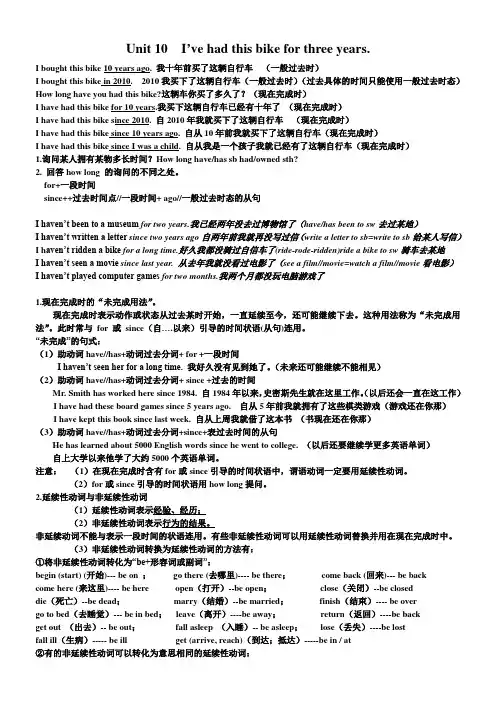
Unit 10 I’ve had this bike for three years.I bought this bike 10 years ago. 我十年前买了这辆自行车(一般过去时)I bought this bike in 2010. 2010我买下了这辆自行车(一般过去时)(过去具体的时间只能使用一般过去时态)How long have you had this bike?这辆车你买了多久了?(现在完成时)I have had this bike for 10 years.我买下这辆自行车已经有十年了(现在完成时)I have had this bike since 2010. 自2010年我就买下了这辆自行车(现在完成时)I have had this bike since 10 years ago. 自从10年前我就买下了这辆自行车(现在完成时)I have had this bike since I was a child. 自从我是一个孩子我就已经有了这辆自行车(现在完成时)1.询问某人拥有某物多长时间?How long have/has sb had/owned sth?2. 回答how long 的询问的不同之处。
for+一段时间since++过去时间点//一段时间+ ago//一般过去时态的从句I haven’t been to a museum for two years.我已经两年没去过博物馆了(have/has been to sw去过某地)I haven’t written a letter since two years ago自两年前我就再没写过信(write a letter to sb=write to sb给某人写信)I h aven’t ridden a bike for a long time.好久我都没骑过自信车了(ride-rode-ridden)ride a bike to sw骑车去某地I haven’t seen a movie since last year. 从去年我就没看过电影了(see a film//movie=watch a film//movie看电影)I haven’t played computer games for two months.我两个月都没玩电脑游戏了1.现在完成时的“未完成用法”。
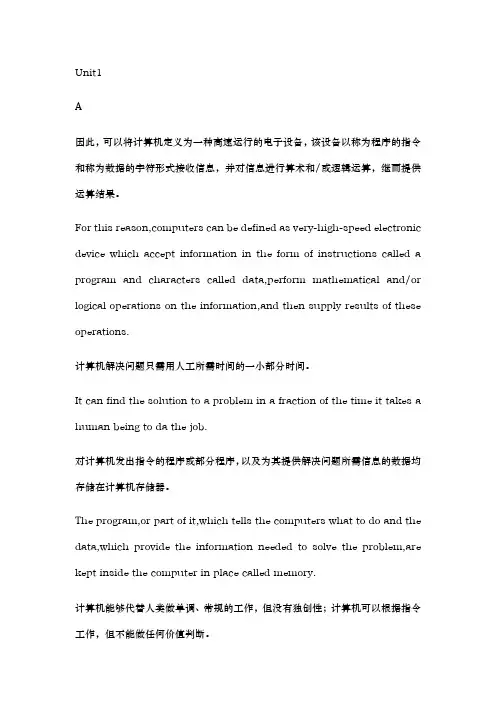
Unit1A因此,可以将计算机定义为一种高速运行的电子设备,该设备以称为程序的指令和称为数据的字符形式接收信息,并对信息进行算术和/或逻辑运算,继而提供运算结果。
For this reason,computers can be defined as very-high-speed electronic device which accept information in the form of instructions called a program and characters called data,perform mathematical and/or logical operations on the information,and then supply results of these operations.计算机解决问题只需用人工所需时间的一小部分时间。
It can find the solution to a problem in a fraction of the time it takes a human being to da the job.对计算机发出指令的程序或部分程序,以及为其提供解决问题所需信息的数据均存储在计算机存储器。
The program,or part of it,which tells the computers what to do and the data,which provide the information needed to solve the problem,are kept inside the computer in place called memory.计算机能够代替人类做单调、常规的工作,但没有独创性;计算机可以根据指令工作,但不能做任何价值判断。
A computer can replace people in dull,routine tasks,but it has no originality;it works according to the instructions given to it and cannot exercise any value judgments.如果操作者不给予指示,也不提供适当信息,计算机就什么也做不了;但由于电脉冲能以光速运行,因此计算机几乎瞬间便能处理大量算术逻辑运算。
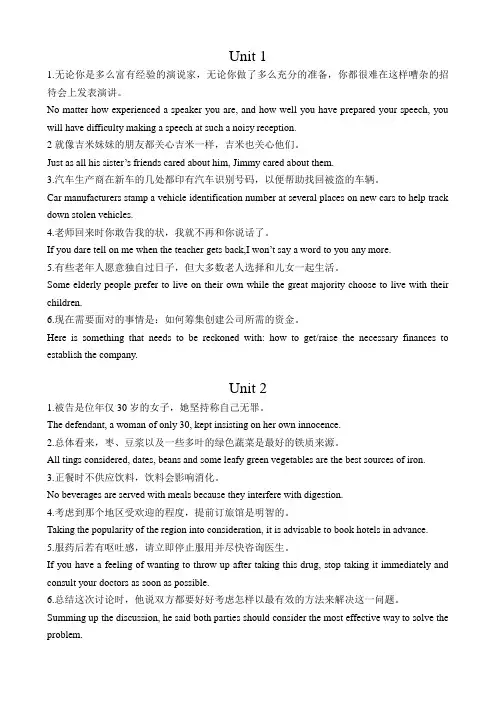
1.无论你是多么富有经验的演说家,无论你做了多么充分的准备,你都很难在这样嘈杂的招待会上发表演讲。
No matter how experienced a speaker you are, and how well you have prepared your speech, you will have difficulty making a speech at such a noisy reception.2就像吉米妹妹的朋友都关心吉米一样,吉米也关心他们。
Just as all his sister’s friends cared about him, Jimmy cared about them.3.汽车生产商在新车的几处都印有汽车识别号码,以便帮助找回被盗的车辆。
Car manufacturers stamp a vehicle identification number at several places on new cars to help track down stolen vehicles.4.老师回来时你敢告我的状,我就不再和你说话了。
If you dare tell on me when the teacher gets back,I won’t say a word to you any more.5.有些老年人愿意独自过日子,但大多数老人选择和儿女一起生活。
Some elderly people prefer to live on their own while the great majority choose to live with their children.6.现在需要面对的事情是:如何筹集创建公司所需的资金。
Here is something that needs to be reckoned with: how to get/raise the necessary finances to establish the company.Unit 21.被告是位年仅30岁的女子,她坚持称自己无罪。
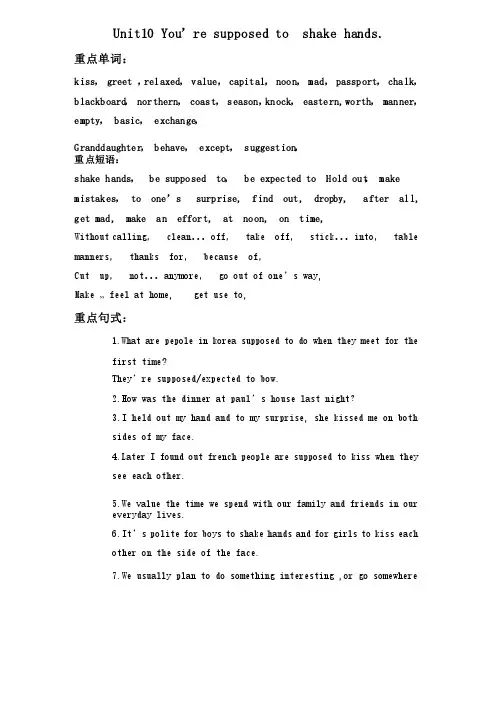
Unit10 You ’re supposed to shake hands.重点单词:kiss , greet ,relaxed , value , capital , noon , mad , passport , chalk ,blackboard , northern , coast , season ,knock , eastern, worth , manner ,empty , basic , exchange ,Granddaughter , behave , except , suggestion ,重点短语:shake hands , be supposed to , be expected to Hold out , makemistakes , to one to one’’s surprise, find out, dropby, after all, get mad, make an effort, at noon, on time,Without calling calling,, clean clean。
off off,, take off take off,, stick stick。
into into,, table manners manners,, thanks for thanks for,, because of because of,,Cut up Cut up,, not not。
anymore anymore,, go out of one go out of one’’s way,Make Make ……feel at home, get use to,重点句式:1.What are pepole in korea supposed to do when they meet for the first time?They They’’re supposed/expected to bow.2.How was the dinner at paul 2.How was the dinner at paul’’s house last night s house last night??3.I held out my hand and to my surprise, she kissed me on both sides of my face.ter I found out french people are supposed to kiss when they see each other.5.We value the time we spend with our family and friends in our everyday lives.6.It 6.It’’s polite for boys to shake hands and for girls to kiss each other on the side of the face.7.We usually plan to do something interesting ,or go somewheretogethere.Sorry Sorry I’I’I’m a little late. m a little late.8.It is worth the trouble if you want to understand anotherculture.9.It 9.It’’s impolite to use your chopsticks to hit an empty bowl.10.You are not supposed to point at anyone with your chopsticks.11.They go out of their way to make me feel at home.12.My biggest challenge is learning how to behave at the dinner table.13.Another 13.Another example example example is is is you you you’’re not supposed supposed to to eat anythjing anythjing with with your hands except bread ,not even ftuit.巧记歌诀;巧记歌诀;巧计few 和littleFew Few,,little 两不和,两不和,Little 不可few 可;可;带a 它就肯定说,它就肯定说,无a 否定语气测;否定语气测;a little 修饰形副前搁;修饰形副前搁;a few 只与名词合。
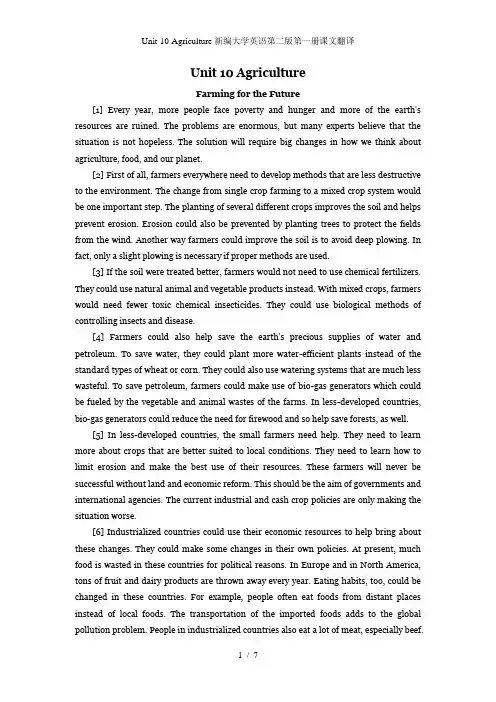
Unit 10 AgricultureFarming for the Future[1] Every year, more people face poverty and hunger and more of the earth's resources are ruined. The problems are enormous, but many experts believe that the situation is not hopeless. The solution will require big changes in how we think about agriculture, food, and our planet.[2] First of all, farmers everywhere need to develop methods that are less destructive to the environment. The change from single crop farming to a mixed crop system would be one important step. The planting of several different crops improves the soil and helps prevent erosion. Erosion could also be prevented by planting trees to protect the fields from the wind. Another way farmers could improve the soil is to avoid deep plowing. In fact, only a slight plowing is necessary if proper methods are used.[3] If the soil were treated better, farmers would not need to use chemical fertilizers. They could use natural animal and vegetable products instead. With mixed crops, farmers would need fewer toxic chemical insecticides. They could use biological methods of controlling insects and disease.[4] Farmers could also help save the earth's precious supplies of water and petroleum. To save water, they could plant more water-efficient plants instead of the standard types of wheat or corn. They could also use watering systems that are much less wasteful. To save petroleum, farmers could make use of bio-gas generators which could be fueled by the vegetable and animal wastes of the farms. In less-developed countries, bio-gas generators could reduce the need for firewood and so help save forests, as well.[5] In less-developed countries, the small farmers need help. They need to learn more about crops that are better suited to local conditions. They need to learn how to limit erosion and make the best use of their resources. These farmers will never be successful without land and economic reform. This should be the aim of governments and international agencies. The current industrial and cash crop policies are only making the situation worse.[6] Industrialized countries could use their economic resources to help bring about these changes. They could make some changes in their own policies. At present, much food is wasted in these countries for political reasons. In Europe and in North America, tons of fruit and dairy products are thrown away every year. Eating habits, too, could be changed in these countries. For example, people often eat foods from distant places instead of local foods. The transportation of the imported foods adds to the global pollution problem. People in industrialized countries also eat a lot of meat, especially beef.In fact, a large percentage of the grain grown in these countries is used for feeding cattle. If people in these countries ate less meat, there would be more grain to feed the hungry people of the world.[7] The ideal agricultural system would be sustainable; that is, its level of productivity could be continued indefinitely and the damage to the environment much less. This is a war which must be won because it would have only winners for both farmers and consumers of farm products.未来农耕1 现在面临贫困和饥饿的人一年比一年多,地球资源遭到的破坏也一年比一年严重。
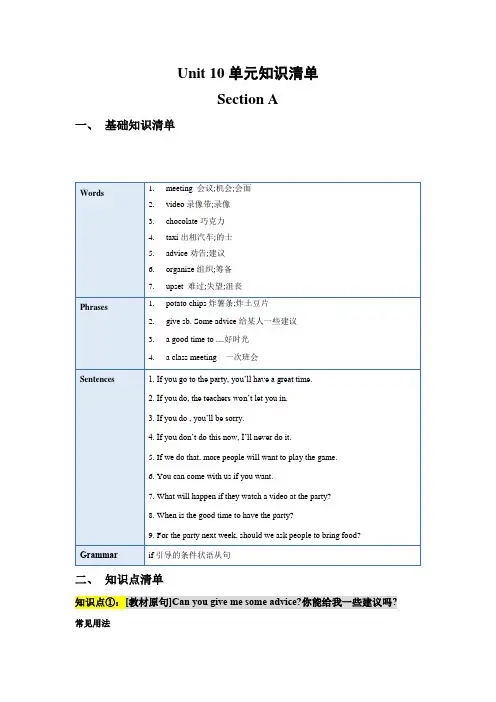
Unit 10单元知识清单Section A一、基础知识清单二、知识点清单知识点①:[教材原句]Can you give me some advice?你能给我一些建议吗?常见用法advice是不可数名词,意为“劝告;建议",可以用some, much, a piece of等修饰。
如a piece of advice意为"一条建议";two pieces of advice意为"两条建议"。
常与advice措配的形容词有good,useful, helpful等。
I need some advice about my computer.我需要一些有关我的电脑的建议。
背例句学搭配My father once gave me some useful advice,我父亲曾经给过我一些有用的建议。
He decided to get some advice from an expert他决定从一位专家那里获得一些建议。
He followed/took his doctor's advice and stuck to a low-fat diet.他听从/采纳了他的医生的建议,坚持低脂饮食。
Can I ask your advice on/about learning English?我能问一下你关于学习英语的建议吗?固定搭配①give sb. some advice给某人一些建议②get some advice ( from sb.)(从某人那里)获得一些建议③follow/take sb. 's advice 听从/采纳某人的建议④ask sb. 's advice on/about..问某人关于...的建议联想拓展advice的动词形式为advise。
advise的常见搭配有:①advise sb. ( not) to do sth.建议某人(不)做某事②advise sb.on/about sth.为某人提供关于某事的建议Evans advised him to leave London埃文斯劝他离开伦敦。
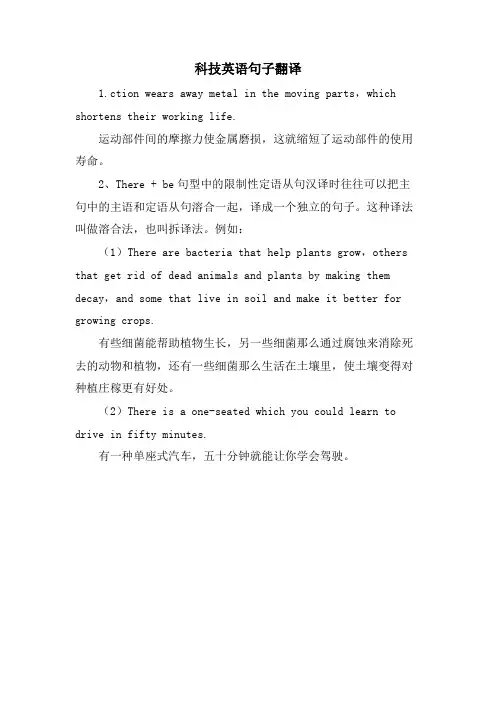
科技英语句子翻译
1.ction wears away metal in the moving parts,which shortens their working life.
运动部件间的摩擦力使金属磨损,这就缩短了运动部件的使用寿命。
2、There + be句型中的限制性定语从句汉译时往往可以把主句中的主语和定语从句溶合一起,译成一个独立的句子。
这种译法叫做溶合法,也叫拆译法。
例如:
(1)There are bacteria that help plants grow,others that get rid of dead animals and plants by making them decay,and some that live in soil and make it better for growing crops.
有些细菌能帮助植物生长,另一些细菌那么通过腐蚀来消除死去的动物和植物,还有一些细菌那么生活在土壤里,使土壤变得对种植庄稼更有好处。
(2)There is a one-seated which you could learn to drive in fifty minutes.
有一种单座式汽车,五十分钟就能让你学会驾驶。
unit10九年级知识点总结Unit 10 九年级知识点总结本文旨在对九年级英语教材Unit 10的知识点进行总结,为学生复习提供一个简洁、清晰的参考。
以下是Unit 10涉及的主要知识点:一、词汇1. 拓展词汇量在本单元中,我们学习了许多新的词汇,如inventor(发明家),electricity(电)和device(设备)等。
这些词汇对于我们了解科技发展和现代生活非常重要。
2. 特定领域词汇在与科技和创新相关的话题中,我们学习了一些特定领域的词汇,如computer(计算机),robot(机器人)和communication (通信)等。
在运用这些词汇时,要注意其正确的用法和拼写。
1. 定义性从句定义性从句用来对主句中的名词进行进一步解释或界定。
如"The computer that John invented is very useful."(约翰发明的计算机非常有用。
)注意,在定义性从句中,引导词常用that,但在口语中可以省略。
2. 时间状语从句时间状语从句用来描述主句发生的时间。
如"We will go to the museum when it stops raining."(下雨停了我们会去博物馆。
)需要注意的是,时间状语从句的引导词有when(当...时)、before (在...之前)和after(在...之后)等。
3. 虚拟语气虚拟语气用来表示与事实相反或不可能实现的情况。
如"If I were you, I would study harder."(如果我是你,我会更加努力学习。
)需要注意的是,虚拟语气中的动词形式有所改变,如be动词的过去式were用于所有主语。
1. 阅读理解在本单元中,我们进行了一些关于科技发展和发明创造的阅读理解练习。
在解题时,我们需要仔细阅读文章,理解文章中的关键信息,并根据问题选择正确答案。
Unit 11.在历时四年的研究中,科学家调查了地球上的许多生境、物种以及将它们联系起来的生态体系。
For four years the scientists examined the planet’s many habitats and species and the systems that bind them together.2.《千年生态系统评估综合报告》为人们提供了认识生态系统经济价值的全新视角,也为人们尊重和保护地球的生命支持体系提供了新的论据。
The Millennium Ecosystem Assessment Synthesis Report gives people a new insight into the economic importance of ecosystem services and some new and additional arguments for respecting and conserving the Earth’s life-support system.3.科学家认为,水文系统的改变可能导致破坏性洪灾的发生更加频繁和严重。
According to the scientists, changes to water systems may increase the frequency and severity of destructive floods.4.从经济角度看,与那些被用于商业开发的生态系统相比,很多原始生态系统的价值更高。
From an economic perspective, compared with the ecosystems altered for commercial use, many intact ones are more valuable.5.如何在利用地球生态系统提高人类生活水平的同时,缓解该系统所承受的压力,完全取决于人类社会。
Unit 10 重点短语和句子I 重点短语1.被期望做…/应该做… be u fortabedoing th = fee good about doing th36 如你想象的一样 a ou can imagine37 发现做某事是…… find it ad to do th38 一家美食餐厅 a fine-dining retaurant39 没有做…… without doing thII.重点句子1.当你第一次见到他人时,你应该做什么?What are ou ueet omeone for the firt time你应该握手。
你不应该吻他。
You’re u I ue?是的,守时很重要。
Ye, it’ ime6.我伸出手时,他鞠躬了。
A oon a I hed out m hand, he bowed7.那就是在日本人们应该互相问候的方式。
8. That’ how hand out9 在我所来自的地方,人们的时间观念相当随意。
Where I’m from, we’re e10.我们珍惜平日生活中与家人、朋友在一起的时光。
We vaue the time we i and friend in our everda ive11 而且,我们也从不事先未打就登门拜访朋友。
Ao, we never viit a friend’ houe without caing firt12 没什么大不了的! It’ no big dea!13 你绝不会相信就因为这样我的法语提高得有多快。
You woudn’t beieve how quic m French ha ime a it ued to15 我最大的挑战是学习餐桌礼仪。
M bigget chaenge i earning how to behave at the dinner tabe 16 除了吃面包,你不能用手拿任何东西吃,即使水果也不行。
You’re not uember everthing, but I’m gradua getting ued to it 18 一路平安,我希望很快见到你。
Sentence TranslationUnit 1Text A1.However, the volume of business done on the Internet is growing rapidly, as people orderbooks and other products to make money transactions.但是,因特网上的交易数量急速增长,人们从网上购书和其他的产品,进行资金交易。
2.They use them to prowl the Internet, looking for ways to break into computers systems runby banks, telephone companies and even government departments.他们用电脑上网,寻找能够进入银行电脑系统、电话公司的电脑系统、甚至是政府的电脑系统的方式。
3.The first indication of a security breach may be when a customer discovers a fraudulentmoney transaction on a credit card account.当顾客发现信用卡的帐号上出现了来历不明的消费时,这可能就是安全受到了破坏的第一个标志。
4.The use of credit cards to buy things on the Internet converts the issue of Internet securityinto one of general security.用信用卡在网上购物使网络安全变成了大众所普遍关注的安全的一种5.Few people think twice about giving a credit card number over the phone and many areequally careless about what happens to the carbon copy when completing a transaction over the counter.很多人会在电话里随意报出自己的信用卡号码,同样地,也有很多人不留意交易完成后放在银行柜台上的副本。
(此句翻译要注意习语,还要正确划分句子的语法结构。
)6.These are atta ched to documents or messages being received, and lodge in computer’s harddrive.这些病毒藏在收到的文件或邮件上,进入到电脑的硬盘。
Text B1.Processing means handling or manipulating the material that has been presented to themachine in such ways as performing calculations, classifying information, or making comparisons.数据处理就是以计算、分类、比较的方式来处理那些预先存放到机器中的资料。
(此句的翻译要注意的有被动形式的定语从句,还有状语的翻译。
)2. A computer is made of millions of electronic devices that can store the data or switch themthrough complete circuits with different functions at incredible speeds.电脑是由数以百万的电子装置组成的,能够通过具有不同功能的闭合电路,以令人难以置信的高速存储或转换数据。
(此句的翻译也是要注意定语从句和状语结构。
)3.We have all heard of computers plotting the course of rockets, preparing bank statements,predicting elections, forecasting weather, and so forth.我们都听说电脑用于火箭路线的设计、银行文件的处理、选举预测、天气预报等。
4.This is probably due to the fact that computers perform very complex operations in a veryshort time — seconds or even fractions of a second.这可能是因为电脑可以在极其短暂的——几秒甚至是不到一秒的时间里完成非常复杂的运行。
(此句的翻译要点是同位语从句。
)5.His job is to determine what information is needed and what operations the computer mustperform in order to solve a problem.他的工作就是决定计算机需要什么信息,必须要完成哪些运行才能解决一个问题。
Unit 2Text A1. Robots, becoming an increasingly prevalent adjunct in factories and industrial plants throughout the developed world, are programmed and engineered mechanical manipulators designed to perform industrial tasks without human intervention.在发达国家的工厂和车间里,用机器人来充当助手越来越普及,它是经设计并制造出来的机器手,可以独立从事各种工业活动。
2. Most of today’s robots are employed in the automotive industry, where they are programmed to take over such assembly line operations as welding and spray painting automobile and truck bodies.当今的机器人大多用于汽车工业,他们代替人类从事装配线上的操作,诸如给汽车和卡车焊接、喷漆等。
3. Robots already taking over human tasks in the automotive field, are beginning to be seen, although to a lesser degree in other industries as well.在汽车行业,机器人已经代替人类做许多事情,这种机器人在其他行业也开始出现,尽管还不是很常见。
4. Robots are more flexible and adaptable and usually more transportable than other machines.机器人更灵活,更有适应性,并且通常比其它机器更易于移动。
5. It is not yet known whether robots will one day have vision as good as human vision.将来某一天机器人是否能够具备和人一样好的视力还未可知。
Text B1.But the fact that others are starting to use it again suggests that AI has moved on from being seen as an overambitious and under-achieving field of research.但其他人从新开始使用人工智能的事实表明人工智能已从被视作是预期过高而成就很低的研究领域摆脱出来。
2.The expression provided an attractive but informative name for a research program that encompassed such previously disparate fields as operations research, cybernetics, logic and computer science.这种措辞为一个之前包括如运筹学、控制论、逻辑学和计算机科等不同的研究领域取了一个迷人而且信息量十足的名字。
3.By the late 1980s, the term AI was being avoided by many researchers, who opted instead to align themselves with specific sub-disciplines such as neural networks, agent technology, case-based reasoning, a nd so on’.在二十世纪八十年代末,很多研究人员避免使用人工智能这一术语,他们选择进行更详细的分支学科如神经网络学、代理技术、实证理论等的研究。
4.In particular, the problem of information overload, exacerbated by the growth of e-mail and the explosion in the number of web pages, means there are plenty of opportunities for new technologies to help filter and categories information - classic Al problems.特别要指出的是,信息超载、电邮数量的激增以及网页数量的急剧增加等问题意味着有大量的机会来研究新技术以帮助需要信息分类的人工智能问题进行过滤和分类。
5.It may be, however, that the comparison with HAL no longer seems quite so important, and Al can now be judged by what it can do, rather than by how well it matches up to a 30-year-old science-fiction film.然而,和HAL的比较可能不再那么重要。